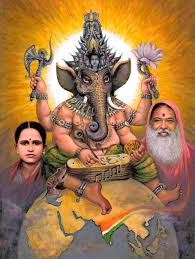The next hymn is composed by the Vānara Gavaya - āmishī kṛta mārtānḍam goshpadīkṛta sāgaram Truni kṛta dasagrīvam ānjaneyam namāmyaham. Meaning- I bow to Lord Anjaneya, who tried to gulp down the Sun as if it were a small edible snack; who crossed the vast ocean as easily and playfully as if it were a tiny puddle holding an ounce of water and in whose opinion the 10-headed demon Ravana was as insignificant as a blade of grass.
Goshpadi is the cow’s hoof mark found in the soil. At the maximum, an ounce or two of rain water can collect within this. Hanuman playfully crossed the vast ocean as if he was crossing a goshpadi.
Gavaya was a Vanara king of another land, who joined hands with Rama and Sugriva in their war against Ravana. Through this strange hymn he brings out the glory of Hanuman.
This is a very popular hymn. Those who have not heard of it earlier should also learn and recite it regularly. This hymn summarizes the entire story of Hanuman and the entire story contained in Sundara Kanda.
Tulsidas in his Hanuman Chalisa states- Yuga sahasra yojana para bhanu, leelyo taahi madhura phala jaanoo. It means-‘O Lord, You considered the Sun, which was billions of miles away, as a fruit and tried to reach it. This act led to your being blessed with the name Hanuman’. Swamiji has translated this Hanuman Chalisa into Telugu with the meaning intact and quite a few recite it regularly in Telugu.
There are two versions of the story of Hanuman trying to catch the Sun. One version states that little Hanuman, saw the glowing Sun and assuming it to be a fruit rushed to grasp it and in the process was hit by Lord Indra’s thunderbolt. The other story is that Anjaneya saw the small rising Sun and assuming it to be a fruit, put it in his mouth and this led him to be hit by Indra’s thunderbolt.
It is immaterial whether he simply grasped the Sun or put it in his mouth. The truth is that this action of his subsequently caused him to be hit by Lord Indra’s thunderbolt. Due to the impact of the blow, Anjaneya’s jaws swelled up enormously. At that point of time He was bestowed with the name Hanuman.
‘Hanu’ means large jaws. The one who possesses large, enormous jaws is known as Hanuman. The other meaning behind the name ‘Hanu’ is knowledge (jnana). Hanuman thus means one who is proficient in all forms of knowledge. Thus from both these angles, this name is aptly suited to Him.
If even to fly up to the Sun requires tremendous courage, trying to catch and eat the Sun requires unimaginable power and strength, does it not? We do not even possess the capacity to gaze directly at the Sun. Therefore, this act of Anjaneya, trying to gobble the Sun, led to his limitless fame. This incident of his childhood days had no witness.
Rama, who desired that his devotee’s greatness should come to the limelight, created a suitable opportunity by ensuring Hanuman crosses the ocean. Through accomplishment of this unimaginable task, Hanuman’s greatness and glory became well known. The actions of Rama and Hanuman reflect their wonderful traits and attitude. They bring out the deep essence hidden within them. Hanuman sought that his Lord Rama should kill Ravana and subsequently be credited with endless fame. Rama wanted his devotee Hanuman to cross the ocean and be blessed with eternal fame.
If Rama willed, could He not have crossed the ocean on his own? Could He not have used his magical powers to carry the entire army of Vanaras across the ocean? Here He used this opportunity to bring out to the world the greatness hidden within Hanuman.
